1994 CADILLAC FLEETWOOD instrument panel
[x] Cancel search: instrument panelPage 45 of 398
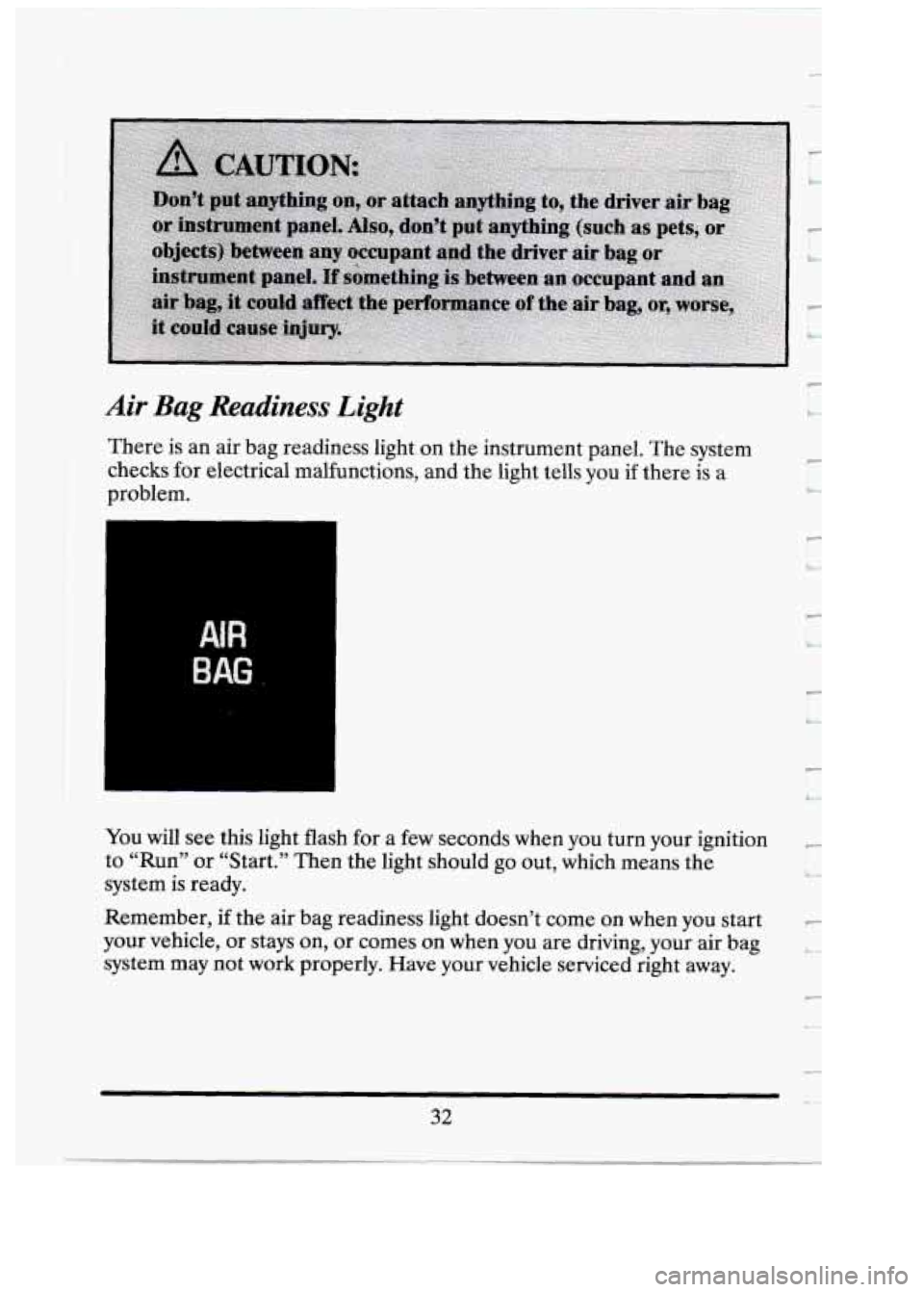
Air Bag Readiness Light
There is an air bag readiness light on the instrument panel. The system
checks for electrical malfunctions, and the light tells you if there is a
problem.
AIR
BAG
You will see this light flash for a few seconds when you turn your ignition
to “Run” or “Start.” Then the light should go out, which means the
system is ready.
Re.member,
if the air bag readiness light doesn’t come on when you start
your vehicle, or stays on, or comes
on when you are driving, your air bag
system may not work properly. Have your vehicle serviced right away.
32
Page 47 of 398
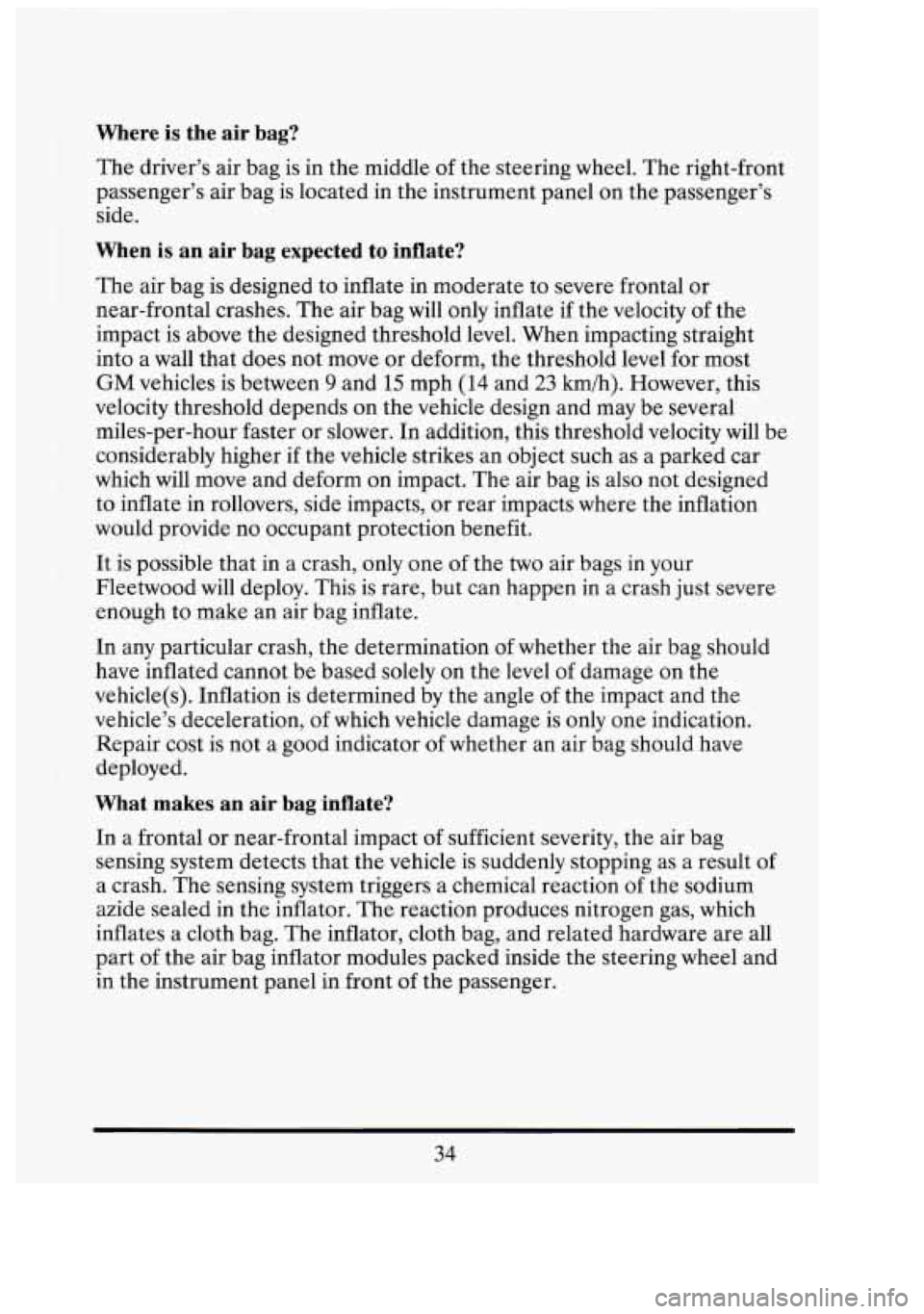
Where is the air bag?
t
The driver’s air bag is in the middle of the steering wheel. The right-front
passenger’s air bag is located in the instrument panel on the passenger’s
side.
When is an air bag expected to inflate?
The air bag is designed to inflate in moderate to severe frontal or
near-frontal crashes. The air bag will only inflate if the velocity
of the
impact is above the designed threshold level. When impacting straight
into a wall that does not move or deform, the threshold level for most
GM vehicles is between 9 and 15 mph (14 and 23 km/h). However, this
velocity threshold depends on the vehicle design and may be several
miles-per-hour faster or slower. In addition, this threshold velocity will be
considerably higher if the vehicle strikes an object such as a parked car
which will move and deform on impact. The air bag is also not designed
to inflate in rollovers, side impacts,
or rear impacts where the inflation
would provide no occupant protection benefit.
It is possible that in a crash, only one
of the two air bags in your
Fleetwood will deploy. This is rare, but can happen in a crash just severe
enough to make an air bag inflate.
In any particular crash, the determination of whether the air bag should
have inflated cannot be based solely on the level of damage on the
vehicle(s). Inflation is determined by the angle
of the impact and the
vehicle’s deceleration,
of which vehicle damage is only one indication.
Repair cost is not a good indicator
of whether an air bag should have
deployed.
What makes an air bag inflate?
In a frontal or near-frontal impact of sufficient severity, the air bag
sensing system detects that the vehicle is suddenly stopping as a result of
a crash. The sensing system triggers a chemical reaction of the sodium
azide sealed in the inflator. The reaction produces nitrogen gas, which
inflates
a cloth bag. The inflator, cloth bag, and related hardware are all
part of the air bag inflator modules packed inside the steering wheel and
in the instrument panel in front of the passenger.
34
al
fl
DI
Page 48 of 398
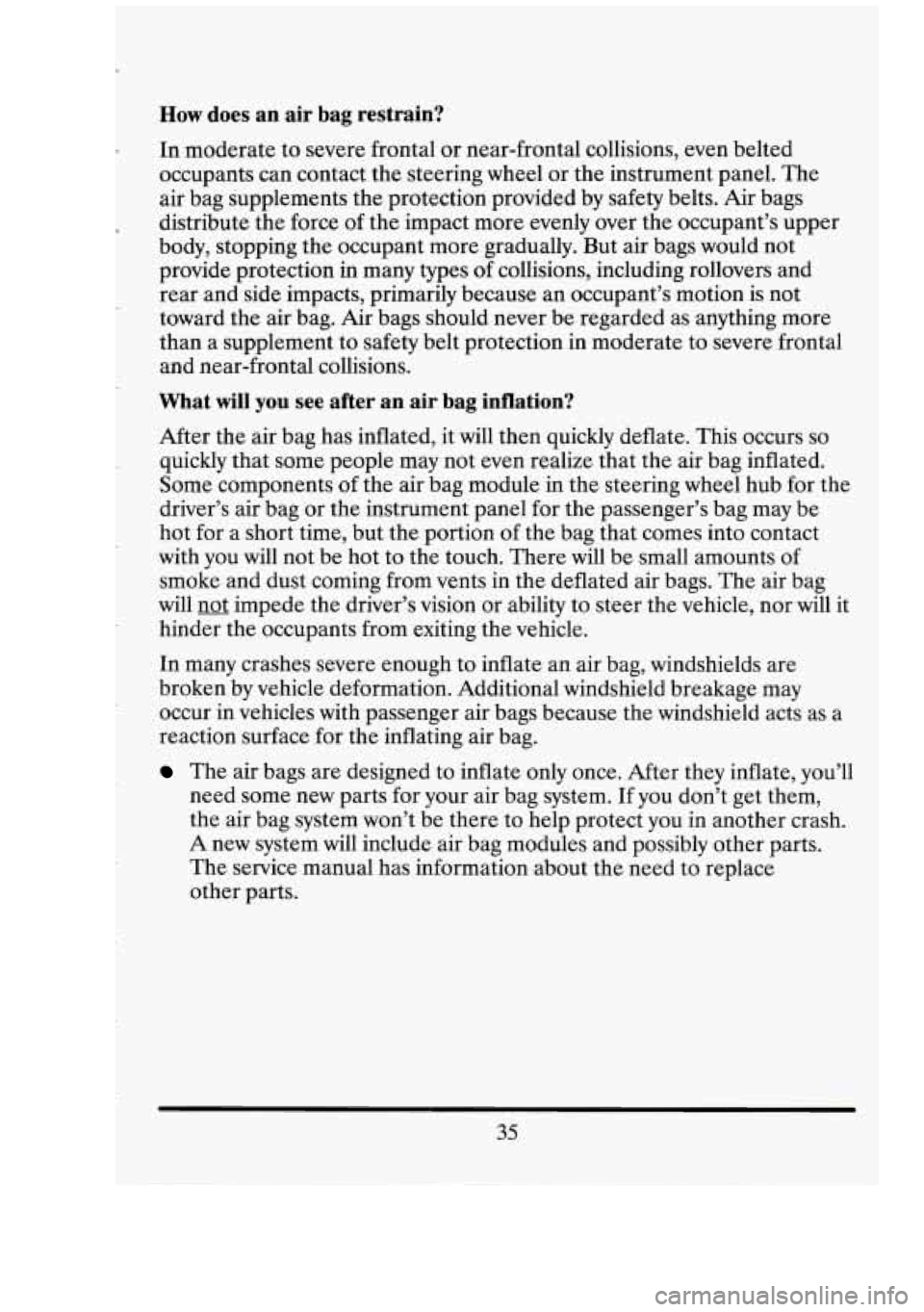
How does an air bag restrain?
In moderate to severe frontal or near-frontal collisions, even belted
occupants can contact the steering wheel or the instrument panel. The
air bag supplements the protection provided by safety belts. Air bags
distribute the force of the impact more evenly over the occupant’s upper
body, stopping the occupant more gradually. But air bags would not
provide protection in many types
of collisions, including rollovers and
rear and side impacts, primarily because an occupant’s motion
is not
toward the air bag. Air bags should never be regarded as anything more
than a supplement to safety belt protection in moderate to severe frontal
and near-frontal collisions.
What will you see after an air bag inflation?
After the air bag has inflated, it will then quickly deflate. This occurs so
quickly that some people may not even realize that the air bag inflated.
Some components of the air bag module in the steering wheel hub for the
driver’s air bag or the instrument panel for the passenger’s bag may be
hot for a short time, but the portion of the bag that comes into contact
with you will not be hot to the touch. There will be small amounts of
smoke and dust coming from vents in the deflated air bags. The air bag
will
not impede the driver’s vision or ability to steer the vehicle, nor will it
hinder the occupants from exiting the vehicle.
In many crashes severe enough to inflate an air bag, windshields are
broken by vehicle deformation. Additional windshield breakage may
occur in vehicles with passenger air bags because the windshield acts as a
reaction surface for the inflating air bag.
The air bags are designed to inflate only once. After they inflate, you’ll
need some new parts for your air bag system. If you don’t get them,
the air bag system won’t be there to help protect you in another crash.
A new system will include air bag modules and possibly other parts.
The service manual has information about the need to replace
other parts.
35
Page 49 of 398

Your vehicle is equipped with a diagnostic module, which records
information about the air bag system if the air bag deploys in a crash.
The module records information about the readiness of the system,
which sensors activated the deployment, and whether the driver’s
safety belt was in use.
Let only qualified technicians work on your air bag system. Improper
service can mean that your air bag system won’t work properly. See
your dealer for service.
NOTICE:
If you damage the cover for the driver‘s or the right-front\
passenger’s air bag, they may not work properly.
You may have
to replace the air bag
on the steering wheel or both the air bag
and the instrument panel for the passenger‘s air bag.
Do not
open or break the air bag covers.
Is the smokefiom an air bag inflation harmful?
The particles emitted during air bag inflation are not harmful to most
people. Some people with respiratory ailments may experience difficulty
breathing
if they stay in the vehicle with the windows closed after air bag
inflation.
So, if your air bag inflates, you and any passengers should exit
the vehicle if and when it is safe to do
so. If you or your passengers can’t
get out of the vehicle, try to get fresh air by opening a window, turning
on
the fan, or opening a door.
36
n
LA
r
LY
31
Jl
Page 80 of 398
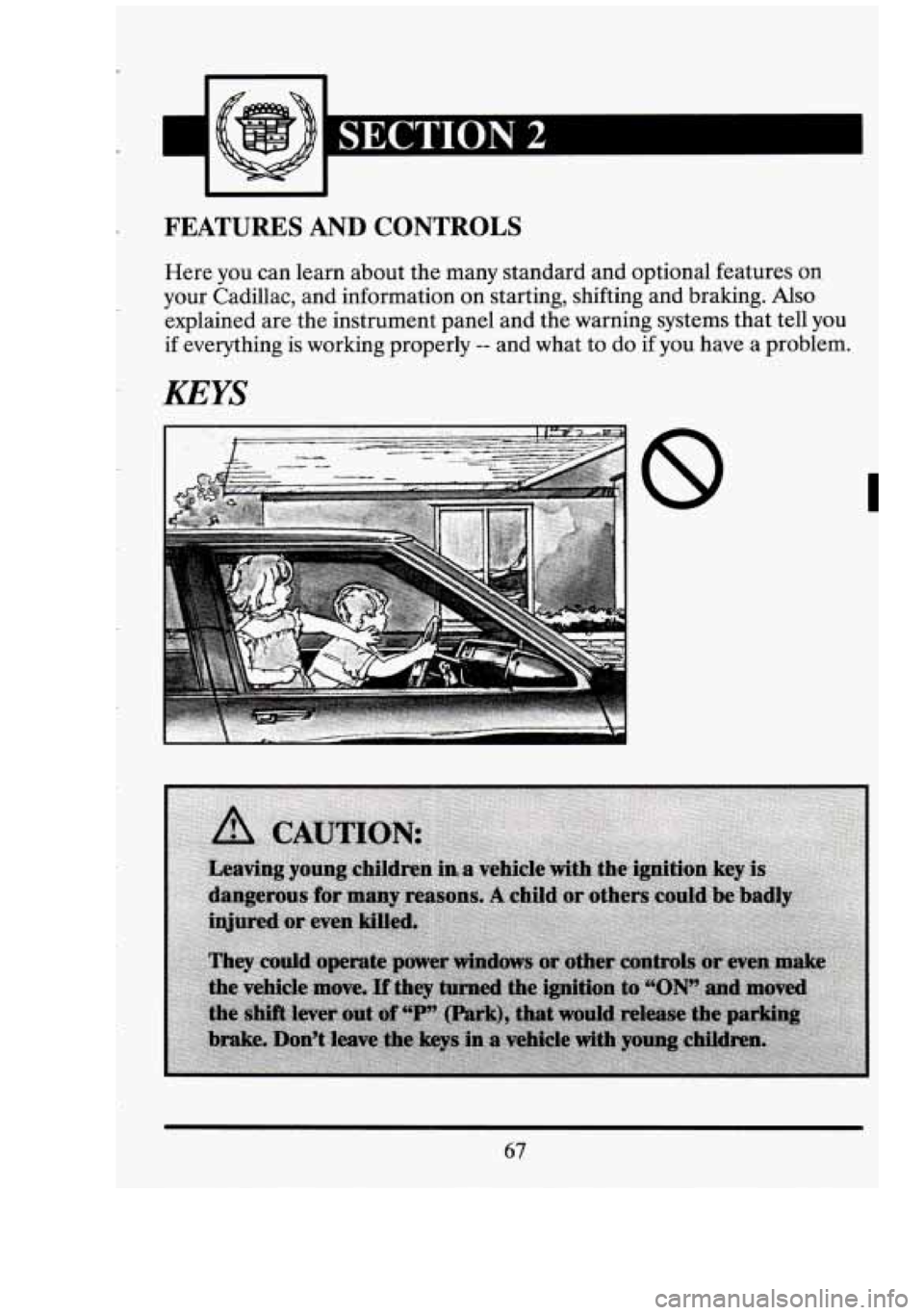
I SECTTON 2 I
FEATURES AND CONTROLS
Here you can learn about the many standard and optional features on
your Cadillac, and information on starting, shifting and braking. Also
explained are the instrument panel and the warning systems that tell you
if everything is working properly
-- and what to do if you have a problem.
KEYS
8
I
I
67
Page 119 of 398

A green arrow on the
instrument panel will
flash in the direction
of
the turn or lane
change.
To signal a lane change, just raise or lower the lever until the green arrow
starts to flash. Hold it there until you complete your lane change. The
lever will return by itself when you release it.
As you signal a turn or a lane change, if the arrows don’t flash but just
stay on, a signal bulb may be burned out and other drivers won’t see your
turn signal.
If a bulb is burned out, replace it to help avoid an accident. If the green
arrows don’t go on at all when you signal a turn, check the fuse (see
“Fuses” in the Index) and for burned-out bulbs.
If you have
a trailer towing option with added wiring for the trailer lights,
a different turn signal flasher is used. With this flasher installed, the
signal indicator will flash even if a turn signal bulb is burned out. Check
the front and rear turn signal lights regularly to make sure they are
working.
Operation of Lights
Although your vehicle’s lighting system (headlights, parking lights, fog
lamps, side marker lights and taillights) meets all applicable federal
lighting requirements, certain states and provinces may apply their own
lighting regulations that may require special attention before you operate
these lights.
For example, some jurisdictions may require that you operate your lower
beam lights with fog lamps at all times, or that headlights be turned on
whenever you must use your windshield wipers. In addition, most
106
-1 I
E,
3’
ii
i
-I
J
Page 120 of 398

jurisdictions prohibit driving solely with parking lights, especially at dawn
or dusk. It is recommended that you check with your own state or
provincial highway authority for applicable lighting regulation.
Headlight High-Low Beam
To change the
headlights from low
beam to high or high to
low, pull the turn signal
lever all the way toward
you. Then release it.
When the high beams
are on, this blue light
on the instrument
panel also will be on.
Flash-To-Pass Feature
This lets you use your high beam headlights to signal a driver in front of
you that you want to pass. It works even if your headlights are off.
To use it, pull the multifunction lever toward you. When you do:
If your headlights are off Your high beam headlights will turn on. They’ll
stay on as long as you hold the lever there. Release the lever to turn them
off.
If your headlights are on. but on low beam: The system works normally.
Just pull the lever. Your headlights will shift to high beam and stay there.
To return to low beam, just pull the lever toward you.
If your headlights are on. and on high beam: Your headlights will switch
to low beam.
To get back to high beam, pull the lever toward you.
107
Page 128 of 398
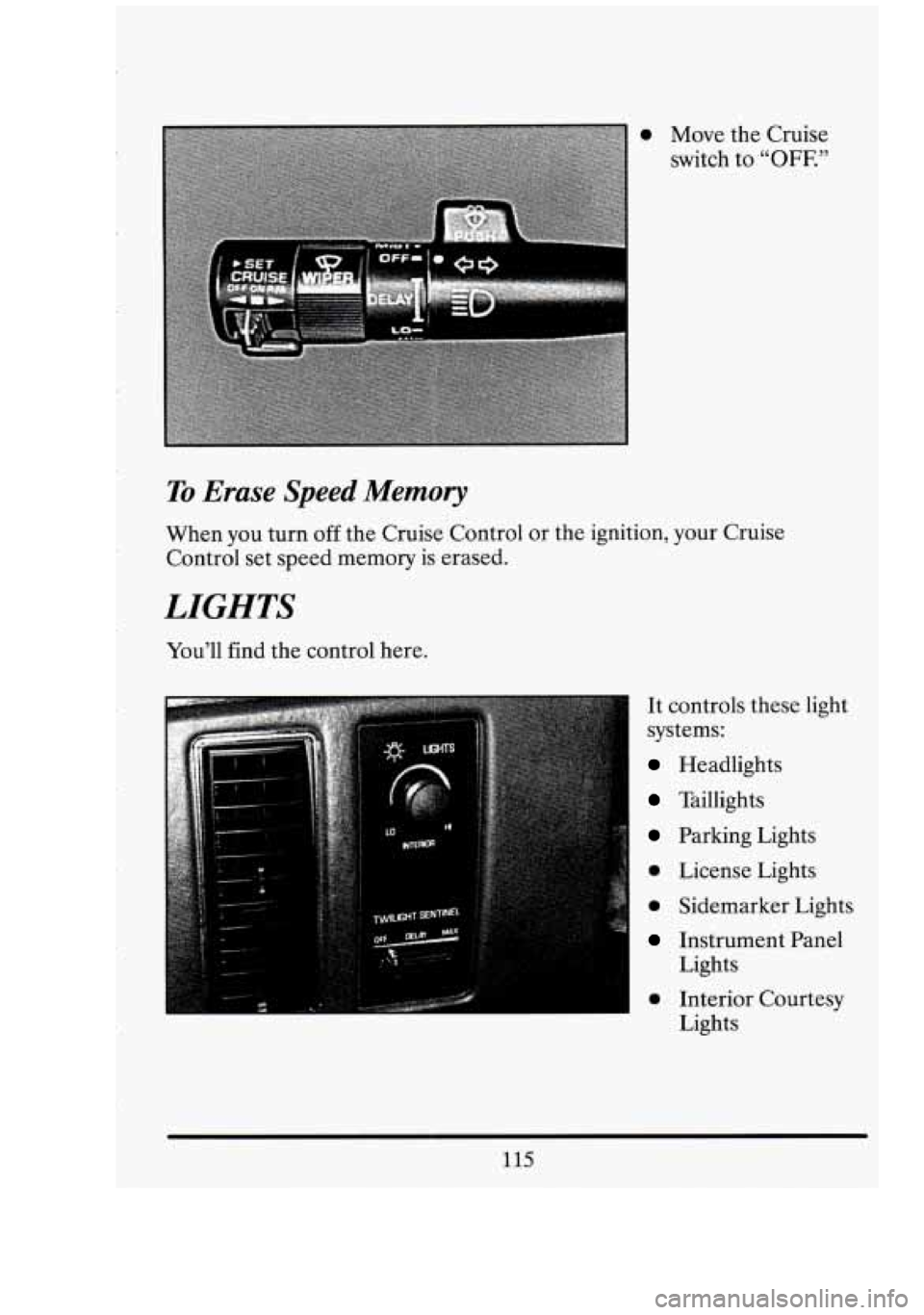
0 Move the Cruise
switch to
"OFF."
To Erase Speed Memory
When you turn off the Cruise Control or the ignition, your Cruise
Control set speed memory is erased.
LIGHTS
You'll find the control here.
It controls these light
systems:
Headlights
Taillights
Parking Lights
0 License Lights
0 Sidemarker Lights
Instrument Panel
I Lights
I 0 Interior Courtesy
Lights
115